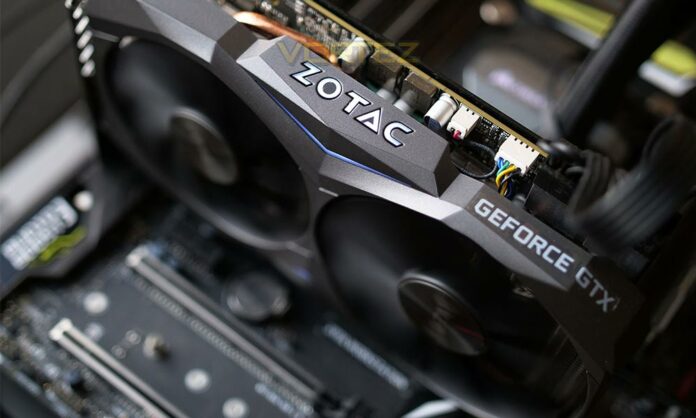Best Low Profile Graphics Card: Low-profile GPUs are significantly smaller than regular graphics cards. These graphics cards for gaming can fit into compact cases that ordinary ones can not. Unless you want to break your case into little bits to make room for your standard graphics cards,
These best low profile graphics card for gaming are ideal for small form factors (SFF) cases and Mini/Micro-ATX cases, and here is where low-profile graphics cards come in. People who possess a low-cost PC or who travel frequently may choose the best low profile graphics card because gaming has become a part of our lives, hasn’t it?
Are low Profile Graphics Card best For Gaming?
Best Low profile graphics card for gaming may be smaller in size, but they deliver great performance. These low-profile graphics cards are ideal for 1080p gaming. Some high-end low-profile graphics cards, such as the RTX 2060XC, are capable of handling 2K gaming at high settings. Furthermore, low-profile graphics cards are just as good as ordinary ones, with fantastic performance and a mind-blowing display.
The performance of the graphics card is entirely dependent on its specs. If your budget exceeds $300, the RTX 2060XC is a wonderful choice, but if you just have a hundred dollars to spare, the RX550 will suffice. Do you want to play casual games on your little PC? These best low profile graphics card reddit will be useful.
Top 15 Best Low Profile Graphics Cards
Here is the list of the best low profile graphics card for gaming that you need to try.
1. GeForce GTX 1060 SC
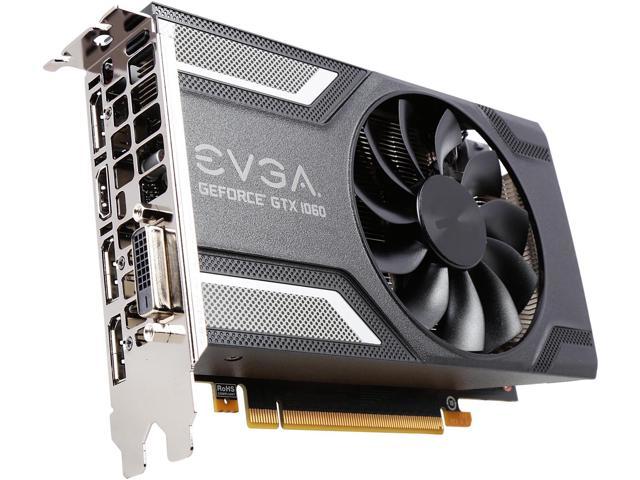
If you’re ready to pay up to $250 for a beast for your tiny build, the GTX 1060 3GB SC is a great option. This one will fit well in your compact form factor case, and the best part about this single-fan graphics card is that it keeps temperatures low.
Despite the poor airflow within these enclosures, the GTX 1060 SC operates at remarkably low temperatures. The GTX 1060 SC has 3GB of GDDR5 memory, a 192-bit memory interface, and basic clock rates of 1607MHz that can be increased to 1835MHz.
The GeForce GTX 1060 micro can handle severe gaming, and if you’re into battle royales like Warzone or Fortnite, this kid can deliver respectable frame rates on high settings.
It will struggle to run graphics-intensive games like Assassin’s Creed and others, but as long as you’re prepared to sacrifice quality, you should be able to maintain a consistent 60 frames per second. You do get a variety of visual outputs, including HDMI and Display Port, allowing you to utilise this card for twin monitor setups.
Because the power supply is only rated at 120W, it will not be an issue. Installing it in the PCIe slot on your motherboard should be a simple affair. Although the low-profile version isn’t as fantastic as the standard one, it won’t let you down, especially when it comes to severe gaming and keeping a solid frame rate throughout the game.
$300-$350 price range
Technical Specifications
- VRAM: 3GB GDDR5
- 1.607MHz is the base clock speed.
- 192-bit memory bus width
- Cuda Cores: 1152
- 12 DirectX
- ROPS-48
- The dimensions are 6.80 x 1.50 x 4.38 inches.
Pros
- Power consumption with a low profile
- Perfect texture detailing.
- can run all of the most recent games.
Cons
- Noise
2. GeForce RTX 2060 XC
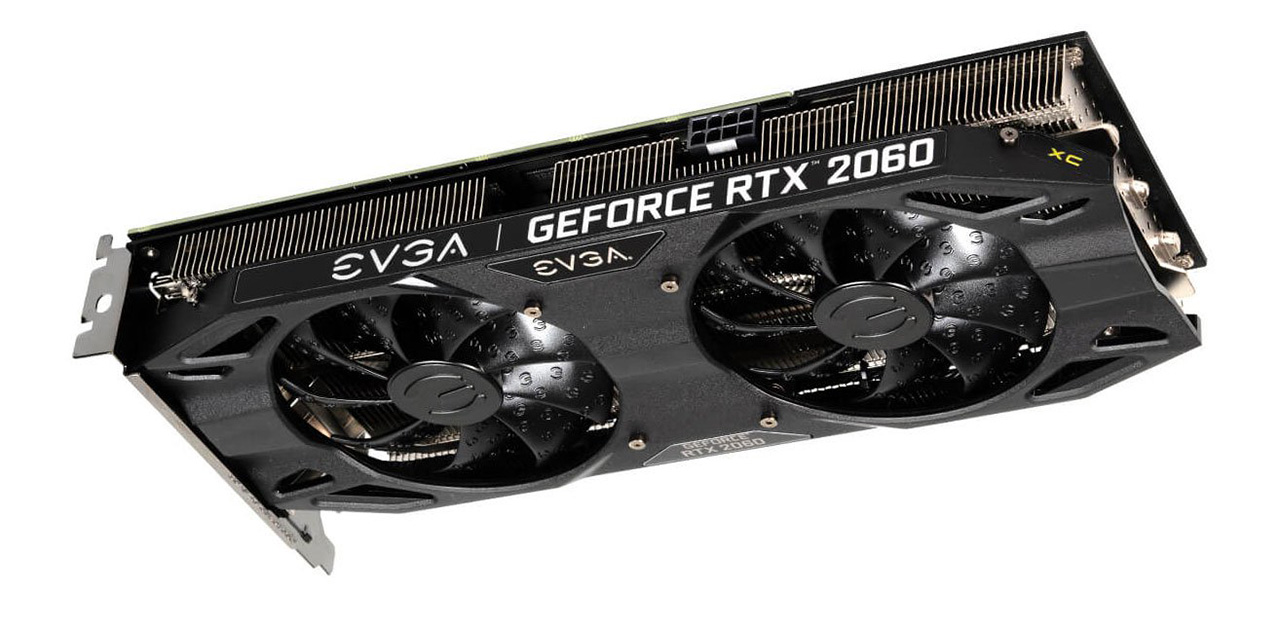
The RTX 2060 is without a doubt one of the best graphics cards ever created, and the low-profile variant, the GeForce RTX 2060 XC, also provides exceptional performance without sacrificing image quality. This single-fan RTX 2060 may fit inside an SFF case, but if you’re using a mini-ATX tower, things will go much more easily. The GeForce RTX 2060 XC comes with 6GB of VRAM and a peak clock rate of up to 1755MHz.
Overclocking your GPU within a compact case is not ideal since the ventilation inside the case is inefficient and the temperatures will skyrocket. We recommend avoiding overclocking anything beneath the hood if you don’t want to convert your GPU into blazing hot lava. The low-profile RTX 2060 is not as good as the normal model, but it is a terrific choice if you want to achieve 60fps+ on a 2K panel.
The RTX 2060 should be able to handle RPGs, MOBAs, MMOs, and first-person shooters. However, you may not want to push any of these to 4K resolution. Because its cooling system isn’t as powerful as its bigger brother’s, it’s best to keep it entirely vanilla.
The RTX 2060 XC is somewhat more costly than the regular version, but we don’t think you’ll receive much better performance than your existing PC setup with RTX enabled. With just a few great low-profile graphics cards on the market, the RTX 2060 XC is undoubtedly one of the best.
The cost is around $400.
Technical Specifications
- VRAM: 6GB GDDR6
- 1.365MHz is the base clock speed.
- 192-bit Memory Bus Width
- 1920: Cuda Cores
- 12 DirectX
- ROPS-48
- Dimensions: 7.48 x 2.75 x 4.38 inches
Pros
- Low temperatures
- Up to 336 GB/s Memory Bandwidth
- Compatibility with G-SYNC
- Ray-Tracing
Cons
- Extremely expensive
3. GeForce GTX 1650 OC
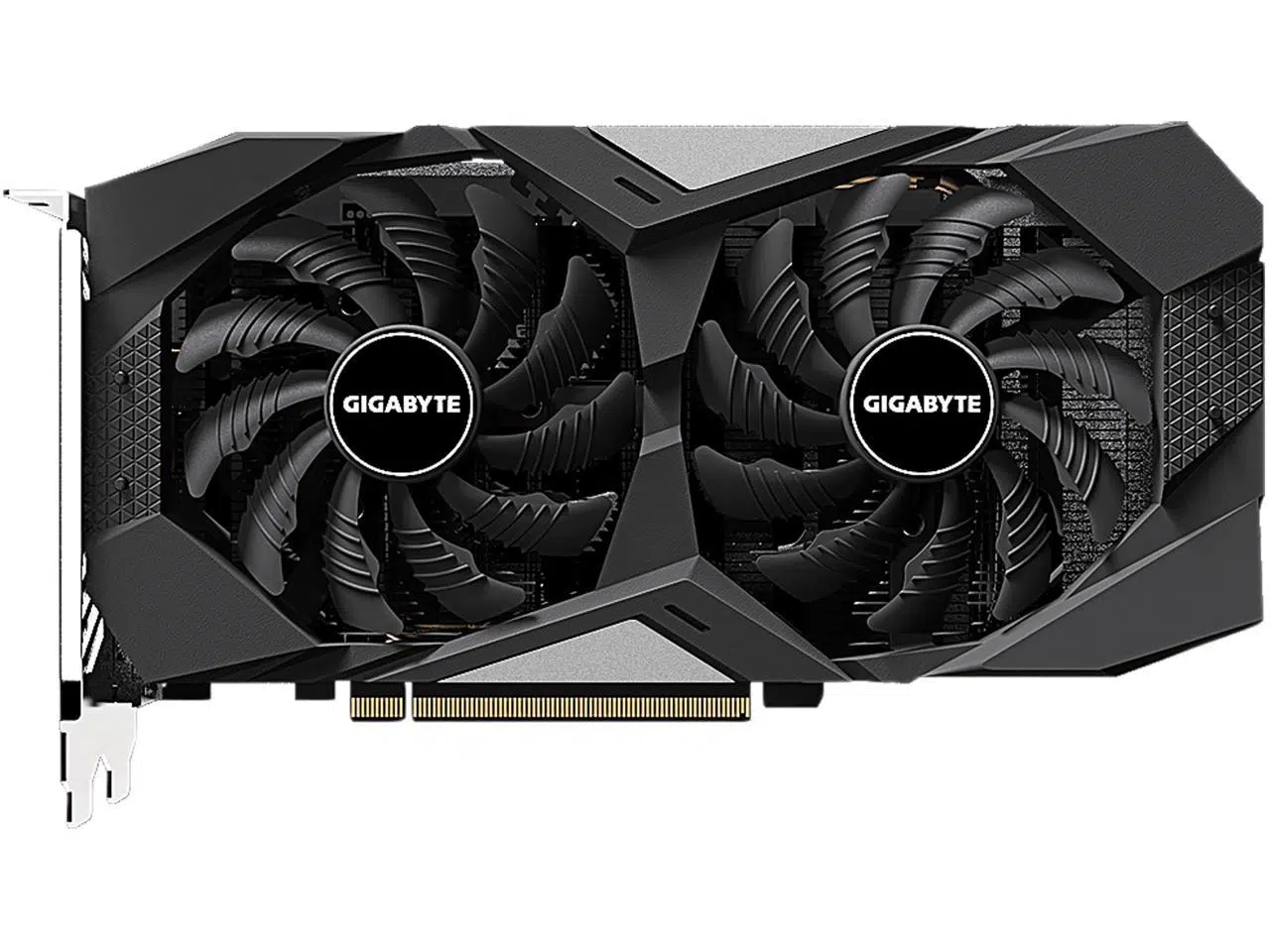
NVIDIA’s GTX 1600 series received worldwide acclaim for its efficient performance while consuming extremely little power. These low-cost graphics cards were able to compete with some of their competitors’ best graphics cards.
The GeForce GTX 1650 OC is an incredible computer that shows brilliant colours while keeping temperatures low. The GeForce GTX 1650 OC also comes in a low-profile variant with twin fans, but they’re so small that you can easily fit them in mini-ITX enclosures.
The GTX 1650 OC comes with 4GB of GDDR5 video memory and a 128-bit memory interface. The normal version of the 1650 OC has the same characteristics, but there may be a little change in performance because low-profile models demand less power and provide less output.
However, don’t be fooled by this fact because it has greater clock rates, up to 1710MHz. It’s even quicker than the standard GTX 1650, which only has a 1665MHz boost. A formidable low-profile monster!
It’s on the tiny side when compared to the other graphics cards on this list, but it does include a variety of visual output connectors, including HDMI and a dual-link DVI-D. Furthermore, if you’re searching for a low-profile graphics card that will last a long time, the GeForce GTX 1650 OC is an excellent choice.
The price range: $200-$250
Technical Specifications
- VRAM: 4GB GDDR5
- 1.695MHz is the base clock speed.
- 128-bit Memory Bus Width
- 1280 Cuda Cores
- 12 DirectX
- ROPS-32
- Dimensions (LxWxH): 6.57 x 2.72 x 1.54 in.
Pros
- Power-efficient
- Budget-Friendly
- Overclockable
- Compliant with NVIDIA ANSEL
Cons
- Noisy
- The build quality is only adequate.
4. Nvidia GTX 1050Ti
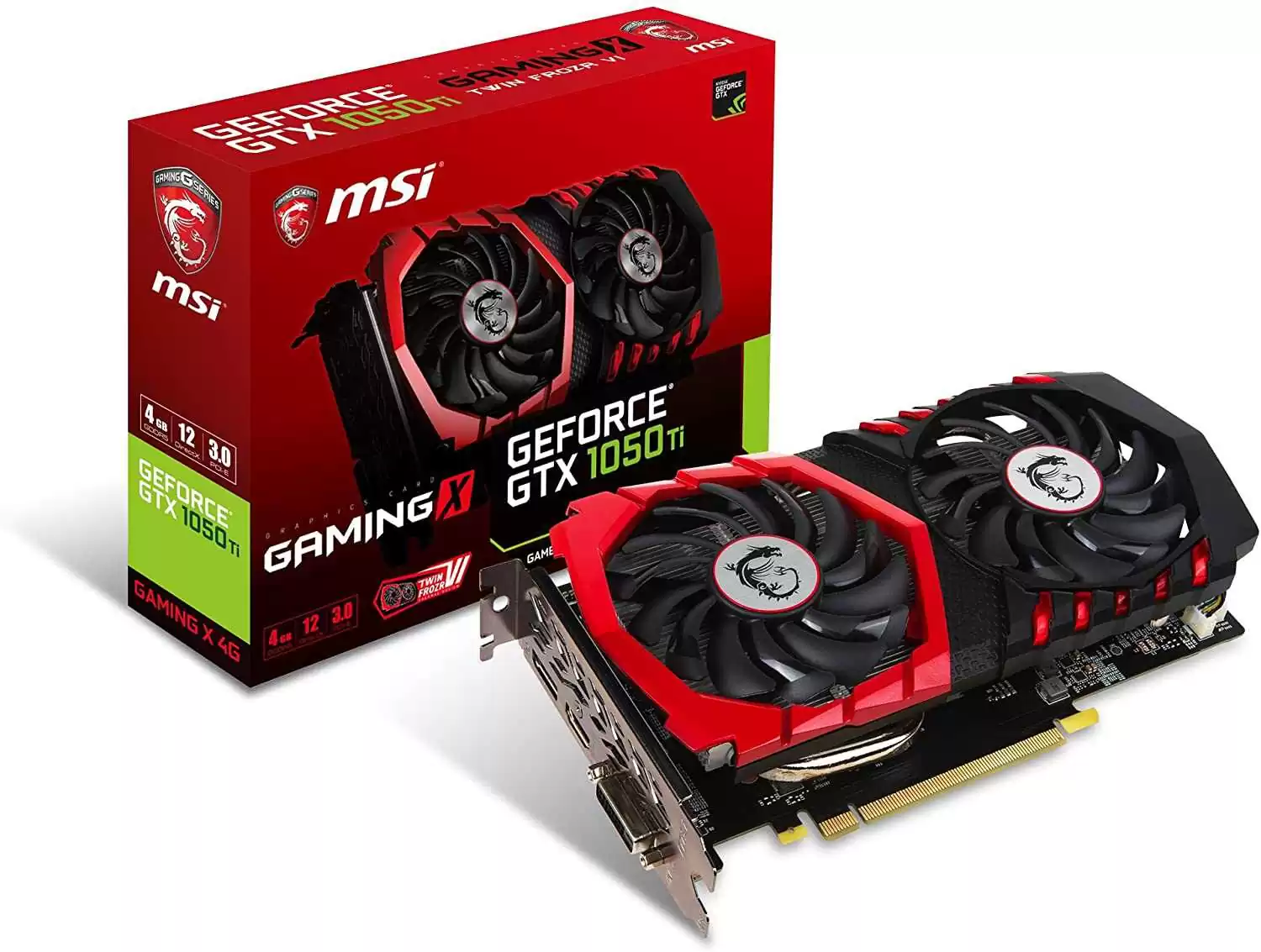
This low-profile GTX 1050 Ti has been around for a while, and we’ve only heard wonderful things about it. The GTX 1050 Ti has 4 gigabytes of GDDR5, but its main advantage is that it only consumes 75 watts from the power supply. It also has a 128-bit memory interface and a 1291MHz base frequency that can be raised to 1392MHz. The little GTX 1050 Ti is a little too small to fit in SFF cases.
The GTX 1050 Ti has a single fan design that can be a little noisy, although this may not be a huge concern for most people. Finding a low-profile twin-fan case is challenging, and with such limited room inside these SF cases, ventilation isn’t the most efficient, but the GTX 1050Ti’s dual fans will keep everything under control.
Aside from its cooling capabilities, you may definitely enjoy mid-setting gaming if it’s not maxed up, which is typical of most low-profile GPUs. This graphics card is 7.09 x 2.72 x 3.5 inches. If you believe a 7-inch GPU can fit in a mini-ATX or Micro-ATX case, this GTX 1050Ti should be among your top three best low-profile GPUs.
The cost is less than $150.
Technical Specifications
- VRAM: 4GB GDDR5
- 1,291MHz is the base clock speed.
- 128-bit Memory Bus Width
- 768 cuda cores
- 12 DirectX
- ROPS-32
- Dimensions (LxWxH): 7.09 x 2.72 x 3.5 in.
Pros
- Twin-Fans
- easily accessible
- high-quality construction
- HDMI Input
Cons
- Outdated
- Slower
5. AMD Radeon RX570
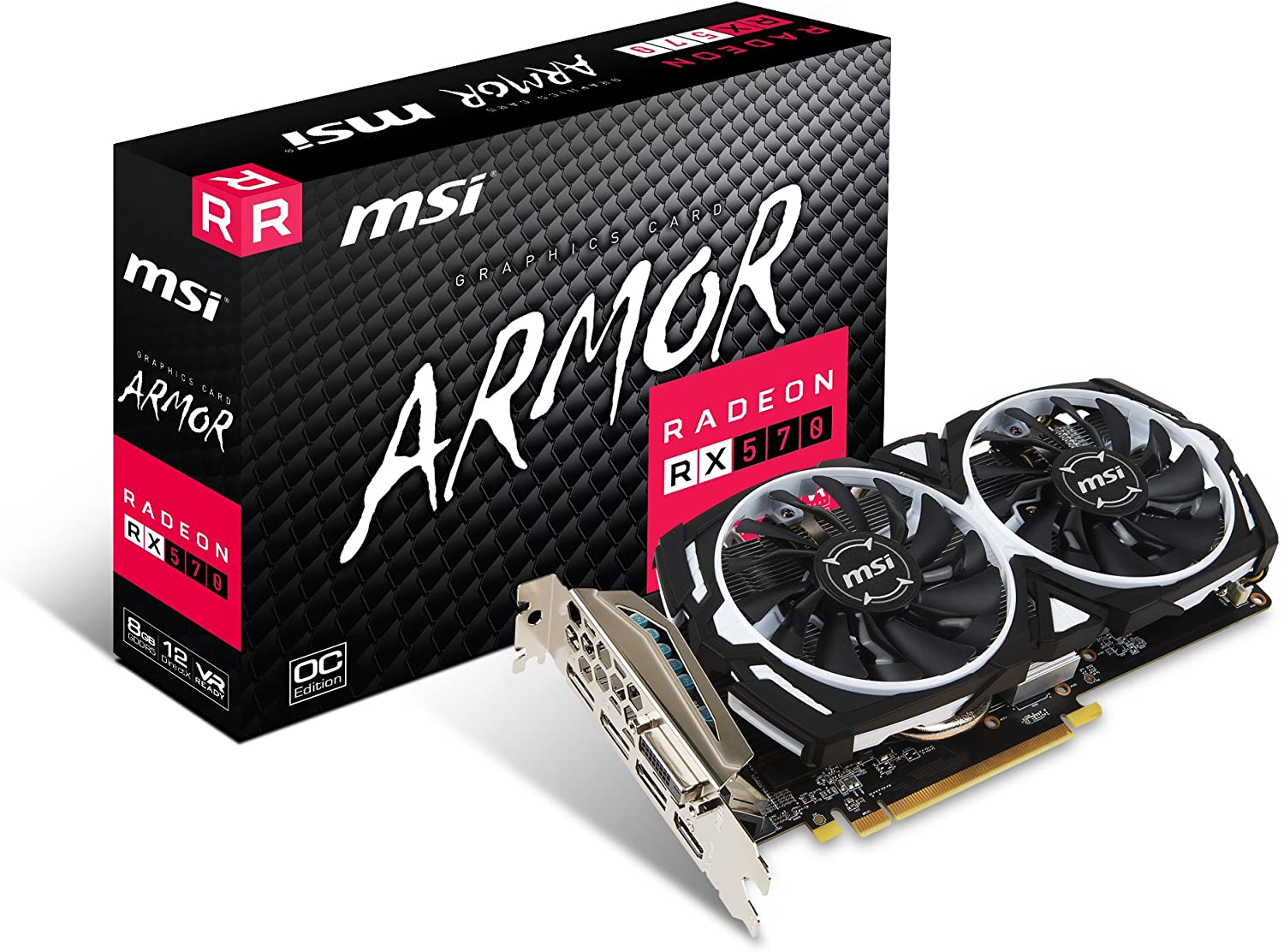
The original Radeon RX570 is powering millions of budget builds throughout the world, and the low-profile single-fan variant is also making waves. The AMD Radeon RX570 low-profile card also has 4GB of GDDR5 RAM and a 256-bit memory interface.
This low-profile GPU lineup is entirely overclockable, but don’t anticipate the temperature to stay in the usual range when you crank it up. The AMD RX570 is a terrific pick for casual gaming, and we highly recommend it. Many pre-built PCs have low voltage power supplies, so a 6-pin socket to power a graphics card is rare.
Most GPUs on the market require 6+2-pin connections, but if you also have a low-voltage power supply, the RX570 will slot right in. When it comes to PCIe slots, small motherboard designs don’t give you many options, but that doesn’t matter with this graphic card because you only need to slip it in.
The single-fan design is particularly appropriate here because it should be a simple pick for anyone constructing a low-profile gaming PC. You won’t have to be concerned about power consumption because the RX570 is designed for low power consumption yet high performance.
$200-$300 price range
Technical Specifications
- VRAM: 4GB GDDR5
- 1,244MHz is the base clock speed.
- 256-bit memory bus width
- 2048 Cuda Cores
- 12 DirectX
- ROPS-32
- Dimensions (LxWxH): 10.50 x 6.50 x 2.50 in.
Pros
- power-efficient
- Extremely cost-effective
- A little slower.
- Overclockable
Cons
- It is difficult to find.
6. AMD Radeon RX560
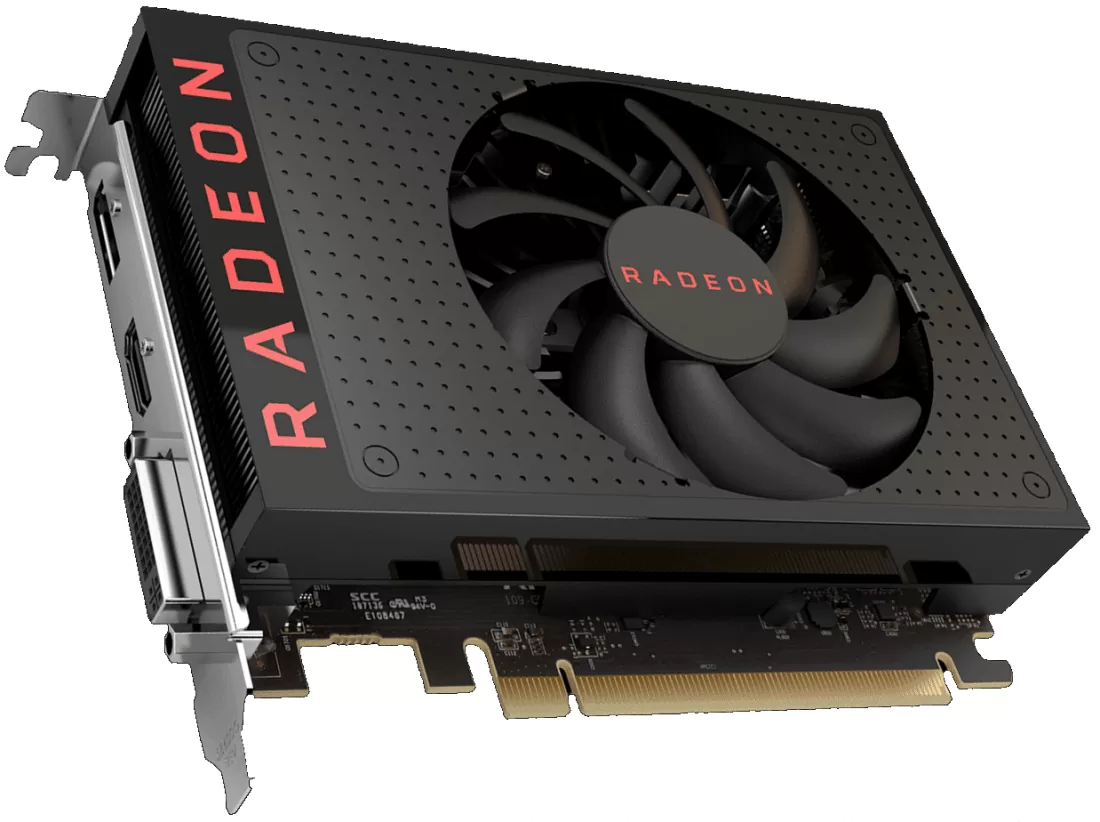
A 2 GB low-profile graphics card may not seem like much these days, but for those looking to create an entry-level computer, the AMD Radeon RX560 is a great choice. Despite having only 2GB of GDDR5 RAM and a 128-bit interface, this low-profile graphics card is capable of handling 1080p gaming on low to medium settings.
You can get your hands on this for about $100, but if you’re ready to spend a little more, the 4GB edition, which is somewhat more expensive, should also be considered. This low-profile single-fan GPU isn’t the fastest graphics card available, and you could do better, but for the price, you’re getting a really good deal.
This GPU’s build quality and overall performance will far exceed your expectations. Instead of a nicely rendered slideshow, the latest AAA titles will provide you with some sufficient frame rates.
The AMD Radeon RX560 also provides fast rendering with Adobe programmes and 3D design apps such as Blender and Unity. If you’re searching for a low-cost setup for graphic design, the RX560 will come in useful. If you do not require a 2GB graphics card, a 4GB edition of the RX560 is also available. Take a look at both of them before deciding which one is best for you.
The cost is less than $100.
Technical Specifications
- VRAM: 2GB GDDR5
- 1,203 MHz is the base clock speed.
- 128-bit Memory Bus Width
- 1024 Cuda Cores
- 12 DirectX
- ROPS-16.
- Dimensions (LxWxH): 9.50 x 6.60 x 2.10 in.
Pros
- Extremely economical
- Low temperatures
- Excellent build quality.
- Up to five displays can be used.
Cons
- Dropped frames
- There is no warranty.
7. AMD Radeon RX550
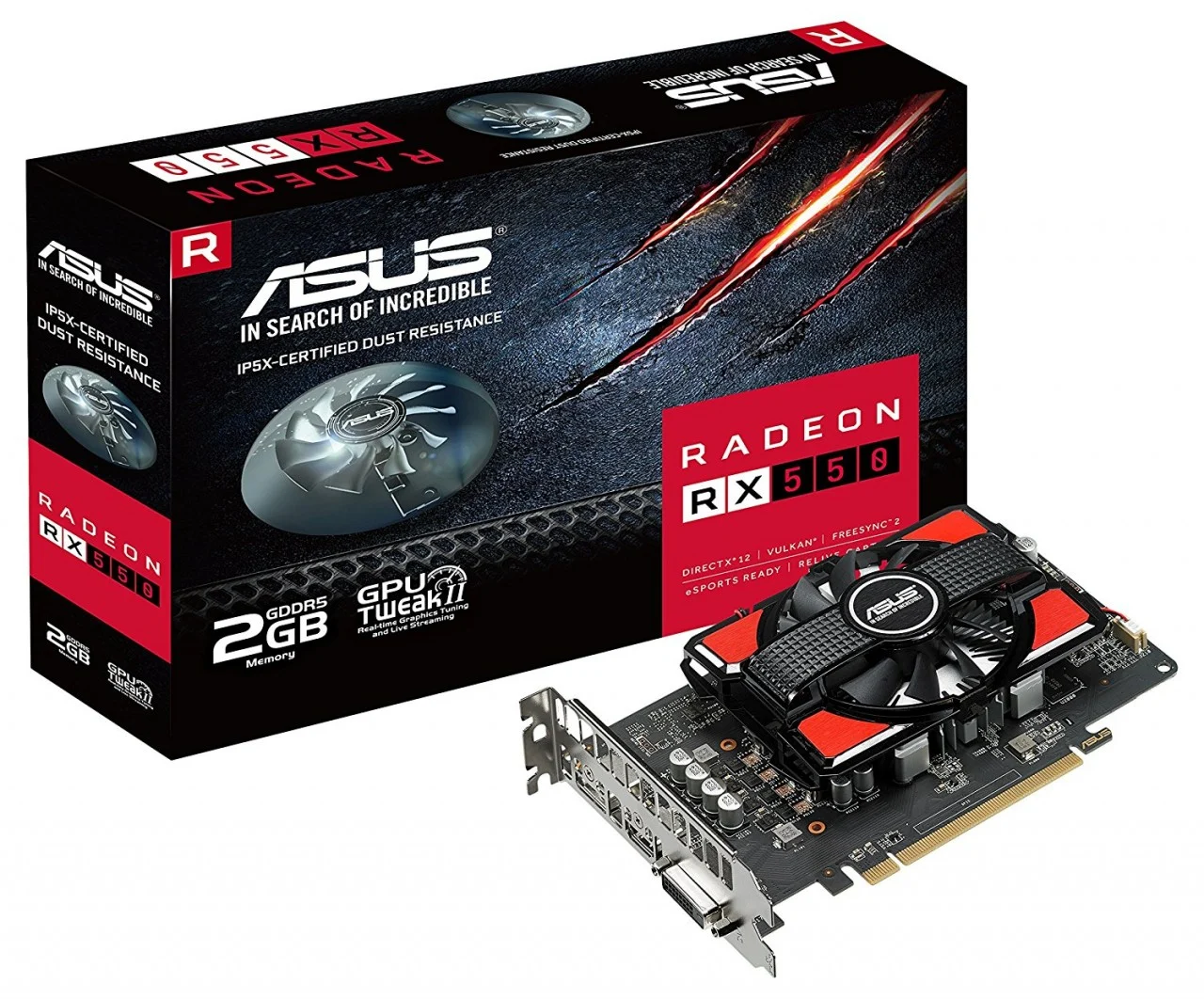
Have we not previously discussed all of the RX series graphics cards? Not at all. The AMD Radeon RX550 is another good graphics card on the market that fits into mini-ATX and micro-ATX systems.
It may also be able to fit inside compact PCs like the Optiplex 9010 and Optiplex 9020, which have 12 inches of room to accommodate a half-height graphics card. Its single-fan architecture comes in handy here because it means that you can utilise it regardless of how small a PC you’re creating.
The AMD Radeon RX550 is also available in two variations. There are 2GB and 4GB varieties; however, in this case, we’ll just look at the 4GB low-profile type. The Radeon RX550 has 4GB of DDR5 RAM with a 128-bit memory interface. The RX550 is a realistic option for an entry-level gaming machine, and even when powered by an ancient processor like the Intel i5-3470, it can deliver mind-blowing frame rates on a 1080p monitor.
However, if you’re anticipating 60fps gaming, you might be disappointed. However, at under $90, you simply cannot get a comparable graphics card that provides the performance that this does. The standard-sized NVIDIA GT1030 is also available for the same price, but it falls short of this low-profile GPU bomb.
Price range: approximately $100
Technical Specifications
- VRAM: 4GB GDDR5
- 1,183 MHz is the base clock speed.
- 128-bit Memory Bus Width
- 512 Cuda Cores
- 12 DirectX
- ROPS-16.
- Dimensions (LxWxH): 6.69 x 1.57 x 4.76 in.
Pros
- It can run the most recent AAA games.
- SFF and Mini/Micro-ATX enclosures are ideal.
- Make as little noise as possible.
Cons
- Poor construction quality (XFX)
8. Nvidia GeForce GT 710
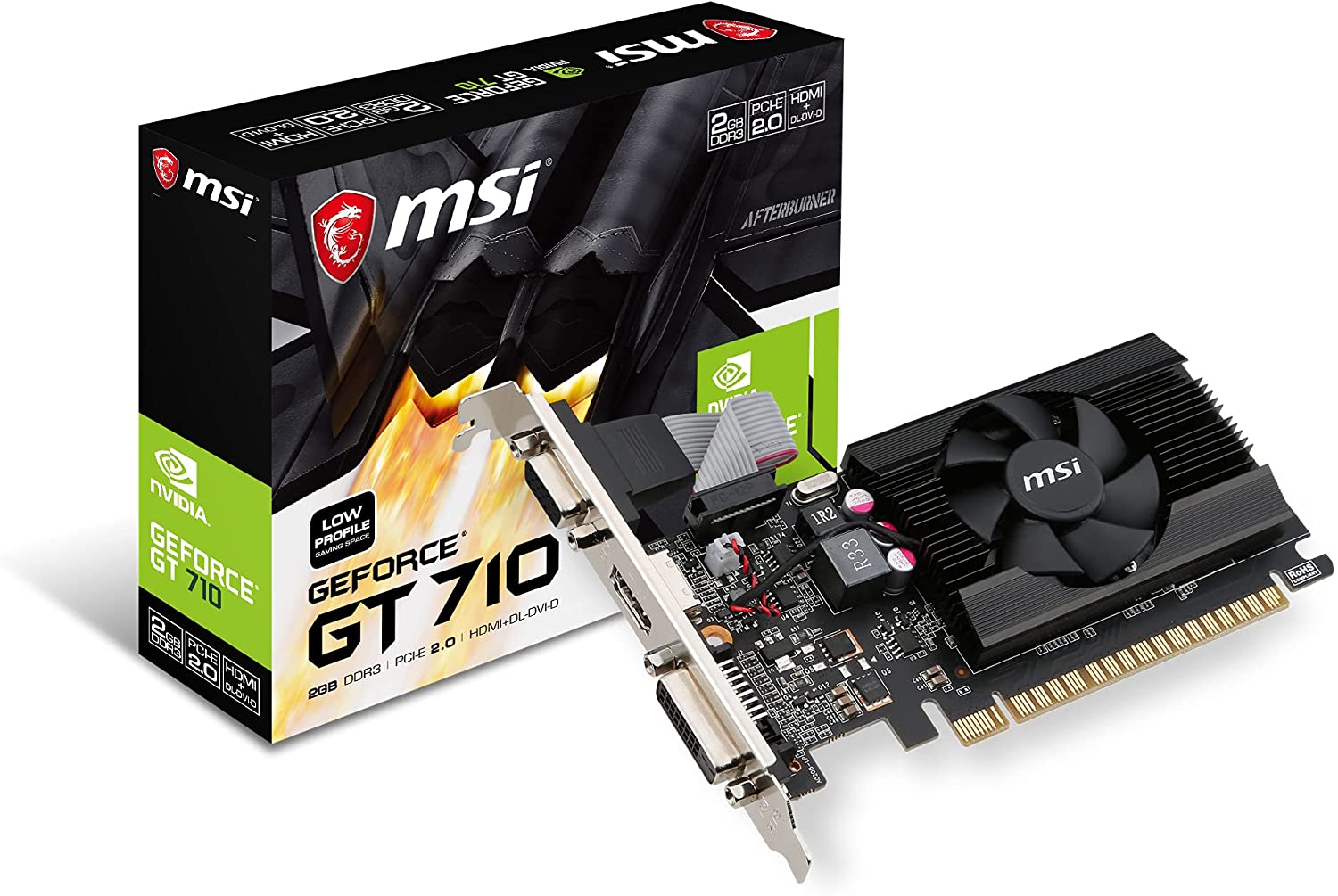
A low-profile NVIDIA-based graphics card on a budget is something you don’t hear about very frequently because all of their cards are fairly pricey. However, the old GeForce GT 710 is still in use and is well-known among people who cannot afford to pay more than $60 for a graphics card.
The GT 710 has 2GB of GDDR3 memory and a 64-bit interface. We realise it won’t be able to run most AAA games from the last few years, but if you prefer Fortnite and GTA V, you can play them on 720p low settings with this.
Most people no longer purchase this graphics card for gaming because it is fairly old. A 64-bit memory interface can’t handle much, so get this one if you just want to view movies on a 1080p or 2K TV. The NVIDIA GT 710 is incredibly compact, especially for low-profile GPUs, measuring 5.75 x 0.75 x 2.72 inches. It should easily fit into any tiny form factor or Micro-ATX enclosure. It’s one of those half-height graphics cards that frees up a lot of room for other components.
less than $50 in cost
Technical Specifications
- VRAM: 2GB GDDR3
- 1.600MHz is the base clock speed.
- 64-bit Memory Bus Width
- 192 Cuda Cores
- 12 DirectX
- ROPS-8
- Dimensions (LxWxH): 5.75 x 0.75 x 2.72 in.
Pros
- It works with a 300w power supply.
- long-lasting
- Compatibility with DirectX 12
- can support a 2K monitor at 60Hz.
Cons
- I cannot cope with new games.
- slow and outdated
9. Nvidia GeForce GT 1030
One might honestly declare that the GT1030 is NVIDIA’s best entry-level graphics card and not be lying. The low-profile GT1030 is one of the best-selling low-profile graphics cards in the world, and it has gained worldwide acclaim. Despite its low 2GB of VRAM and poor speed, the GT1030 is nevertheless selling well, and sales have increased since its release.
The GeForce GT1030 from NVIDIA has 2GB of GDDR5 RAM and a memory interface that is only 64-bit. The GDDR5 memory type is one of the fastest types of VRAM available on the market today, and it is highly fast when compared to GDDR3 and GDDR4 memory types, which is why GT1030 demand is still strong.
All of the excellent AAA titles from 2017–18 can be readily played with reasonable frame rates on the GT1030, but anything beyond that is simply out of reach for this low-profile GPU. Still, the GT1030 would be a solid choice for a low-cost PC build. A low-profile graphics card may also fit in a normal case, but if you already have one, a standard version makes more sense.
Price range: approximately $100
Technical Specifications
- VRAM: 2GB GDDR5
- 1.468MHz is the base clock speed.
- 64-bit Memory Bus Width
- Cuda Cores: 318
- 12 DirectX
- ROPS-16.
- Dimensions (LxWxH): 5.90 x 2.71 x 0.59 Inches
Pros
- maximum resolution of 4096 x 2160p.
- Power usage is low.
- Overclocking in One Click
Cons
- Inefficient heatsink
- Outdated
10. ZOTAC GeForce GTX 1080 Ti Mini 11GB
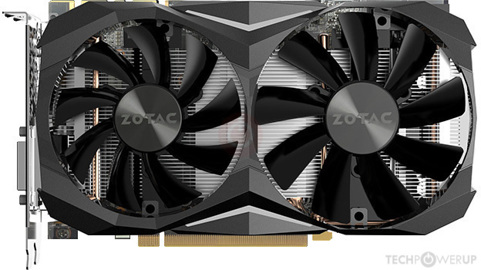
The GeForce GTX 1080 was one of NVIDIA’s flagship cards, and it’s tough to understand how they managed to make it into a low-profile graphics card that can fit into a tiny form factor workstation without sacrificing much of its performance.
This is without a doubt the graphics card to acquire if you want to construct a small PC that can surpass consoles (not the PS5s or the new Xbox). Even though it is a few generations old, the GTX 1080 Ti can still compete in terms of performance.
It’s even quicker than many modern GPUs, particularly low-profile ones. Although it is much smaller than its full-sized equivalents, it does not suffer from slower clock speeds. You may anticipate the same performance while still fitting it into compact form factor projects with mms to spare.
Because Zotac is not known for its substantial cooling system, we anticipate it to run a little hotter than comparable GTX 1080 Ti graphics cards. However, this is a twin-fan low-profile GPU that should withstand lengthy hours with a few additional fans in your PC case. This is one of the most powerful low-profile GPUs available, with a boost frequency of up to 1620MHz and 11GB of GDDR5X memory. As long as you keep to 1080p resolution, playing the latest games should be no problem with this card. However, there are a few games where 4K is still acceptable.
After all, the GTX 1080 Ti was previously the most powerful GPU available to the general public. It’s still a popular choice for gamers and streamers since it works well, especially when playing less resource-intensive games. The GTX 1080 Ti is still one of the best low profile graphics cards available, and this model from Zotac is still a good buy for mini-ITX motherboards.
The cost is less than $700.
Technical Specifications
- VRAM: 11GB GDDR5X
- 1.506MHz is the base clock speed.
- 352-bit memory bus width
- Cuda Cores: 3584
- 12 DirectX
- ROPS – 88
- Dimensions (LxWxH): 8.31 x 1.61 x 4.92 in.
Pros
- High-performance, low-profile graphics card
- Power and performance are comparable to full-sized GTX 1080 Ti cards.
- Outstanding 1080p gaming performance.
Cons
- When compared to other cards, it runs hotter.
- Loud
11. EVGA GeForce RTX 3060 XC Gaming
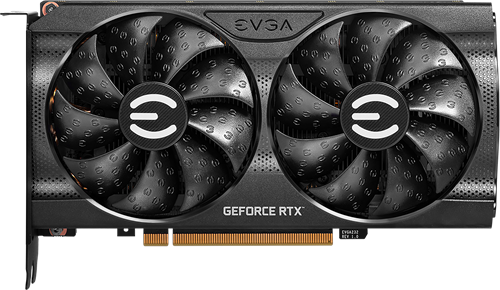
The EVGA GeForce RTX 3060 XC Gaming is not the smallest GPU on this list, but it is one of the more powerful low-profile GPUs available for a mini-ITX setup. It features a smaller form factor than previous RTX 3060s and an effective cooling system to provide the best performance without compromising operational temperatures.
It’s a dual-slot GPU that fits well into the remaining available space in a compact form factor PC. This RTX 3060 card has a boost clock speed of 1777MHz and 12GB of GDDR6 RAM. You may still push it farther by overclocking it to higher clock rates to get every last drop of performance from it.
With its Turing GPU architecture and RTX cores, this is a low-profile GPU that everyone wants to deploy on their compact form factor products. It’s designed for gamers who want to play the newest AAA games at 1440p and 60 frames per second.
Unlike most of the low-profile GPUs on this list, this one is capable of 4K gaming, but don’t anticipate the smoothest frame rates. This RTX 3060 video card provides exceptional performance for video editing operations, saving you time when rendering. It’s a card that outperforms the majority of the others on this list.
The cost is approximately $500.
Technical Specifications
VRAM: 12GB GDDR6
- 1.777MHz is the base clock speed.
- 192-bit Memory Bus Width
- Cuda Cores: 3584
- 12 DirectX
- ROPS-48
- Dimensions (LxWxH): 7.94 x 1.54 x 4.33 Inches
Pros
- 4K gaming capability.
- At 1440p or 1080 resolution, it shines.
- A powerful GPU for a PC with a tiny form factor
- Ray tracing support for that eye delight.
Cons
- On the more expensive side,
- Small improvements in performance over the RTX 2060 predecessor
12. GIGABYTE GeForce GTX 1660 Super Mini OC
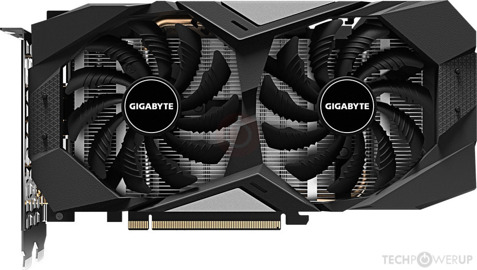
The NVIDIA GeForce GTX 1660 Super is an amazing low-profile, affordable GPU. This GPU, which builds on the GTX 1660 architecture and takes it to the next level, will provide you with a much-needed performance increase while remaining within your budget price range.
When compared to the available low-profile graphics cards, this is bang on the sweet spot. It’s a great option for people who are constructing a rig or looking to update their current gaming PC setup. The GTX 1660 Super is built on NVIDIA’s newest Turing architecture, although it lacks the ray-tracing core.
With a boost frequency of 1800MHz and 6GB of GDDR6 RAM, this graphics card will hardly break a sweat during casual gaming. Despite its smaller size, it does not operate at reduced clock rates and outperforms several full-sized rivals.
You’ll need to set your games to medium settings at 1080p to get them to stretch their muscles. Graphics-intensive games may fall slightly below 60 frames per second, but most should be fine.
Playing games at 1440p can be a bit picky, but it should be able to handle GTA V, Forza Horizon 4, Hitman 2, Shadow of the Tomb Raider, and other titles. Despite being a dual-slot card, the compact form size allows it to be installed in micro ITX setups. It’s a strong GPU that provides far more value than its asking price. It’s one of the best low profile graphics cards you can acquire without having to regret it later.
The cost is around $400.
Technical Specifications
- VRAM: 6GB GDDR6
- 1.530MHz is the base clock speed.
- 192-bit Memory Bus Width
- Cuda Cores 1408
- 12 DirectX
- ROPS-48
- Dimensions (LxWxH): 5.90 x 2.71 x 0.59 Inches
Pros
- Excellent 1080p performance for the price.
- Excellent low-profile graphics card for the price.
- It is not as energy-intensive as other cards in its class.
Cons
- There are no RTX features.
13. PowerColor Radeon RX 5600 XT ITX
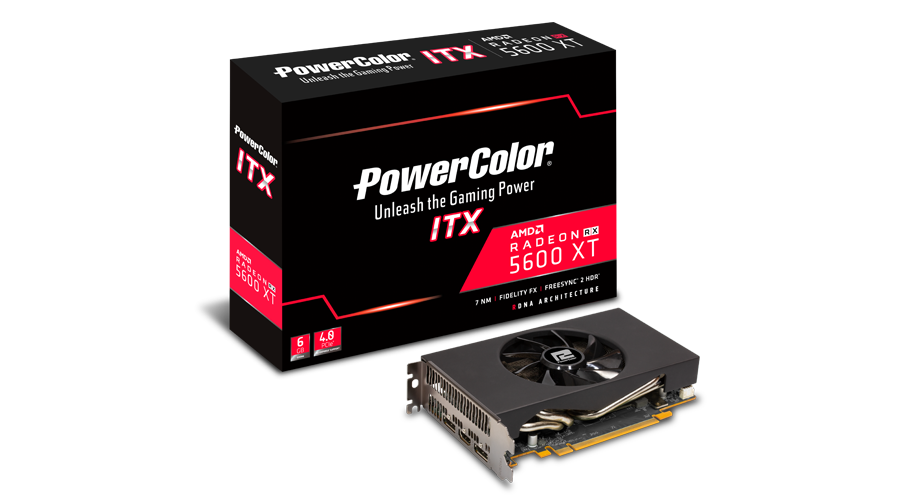
The Radeon RX 5600 XT ITX from PowerColor is a hidden treasure if you’re seeking a dependable low-profile graphics card that can handle 1080p gaming flawlessly. Ours is the best low-profile card on this list in terms of performance, and it also fits in compact form factor setups.
The sole difference between it and the RTX 2060 is ray tracing. It has a lower price tag, is capable of high frame rates, and has a slew of additional capabilities. In reality, there are a number of graphics cards in the 1080p sector. However, not all of them have a low-profile design. These latest hardware components are simply too large to fit within a compact PC casing.
This low-profile ITX edition from PowerColor changes that because it offers far superior performance for its size. As long as you exclude ray tracing features, the RX 5600 XT comfortably outperforms its NVIDIA equivalents. The RX 5600 XT is a powerful card with a base speed of 1560MHz and a boost clock of up to 1620MHz.
You may even enable OC mode to get extra performance out of your card. 6GB of GDDR6 memory may appear to be insufficient when compared to competitors, but it is a necessary sacrifice to keep the price and size low.
It is simple to get this graphics card to work. It is advised that you install it in a PCIe 4.0 slot to fully utilise its advantages. There are also three display options, providing you with the flexibility to work with numerous displays easily. This is the card to get if you’re building a gaming rig on a mini-ITX motherboard. You’ll be able to play 1080p games at a respectable frame rate.
Price: approximately $350
Technical Specifications
- VRAM: 6GB GDDR6
- 1.560MHz is the base clock speed.
- 192-bit Memory Bus Width
- Cuda Cores: 2304
- 12 DirectX
- ROPS-64.
- Dimensions (LxWxH): 6.9 x 4.3 x 1.6 in.
Pros
- It has the best 1080p performance in its class.
- One of the most affordable GPUs in its class.
- The small size fits almost any PC case.
- Power usage is low.
Cons
- There is no ray tracing.
- 6 GB of RAM appears to be insufficient for such tasks.
14. MSI Radeon RX 560 AERO ITX OC 4GB
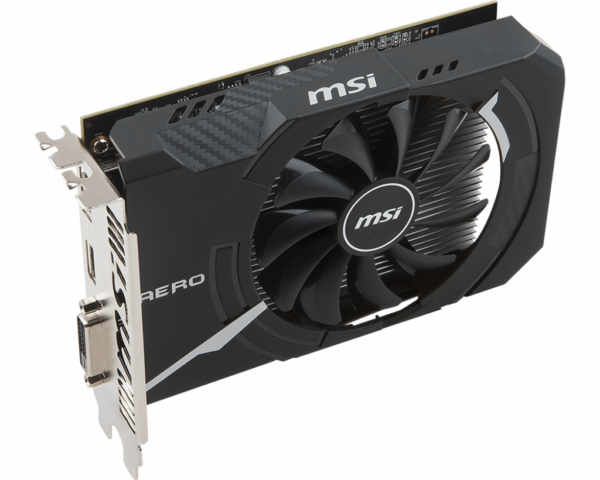
The MSI Radeon RX 560 Aero ITX is a low-profile graphics card with limited 1080p performance. It’s not the most powerful low-profile GPU on this list, but if you’re ready to compromise on graphics quality and set it to medium, you’ll be OK. If you have a limited budget for PC gaming, this is one of the cards that will make a lot of sense.
There are several genuinely cheap graphics cards available, but at this price range, you can’t argue with the RX 560’s instant value for your build. It’s a small dual-slot GPU with a single fan. You should have no trouble incorporating this into your little system.
Despite its small size, it has many video output connectors that provide critical support for HDMI ports or external screens. Because of its boost clock rates that may reach 1196MHz, you should anticipate good performance.
The 4GB of GDDR5 RAM also aids in the quick loading of textures, making this one of the greatest low-profile GPUs available for under $100. The best configuration for this card would be low to medium settings at 1080p. At 60 frames per second, you’ll be able to play games like The Division, The Witcher 3, World of Warcraft, and others.
Light gaming should be simple, such as League of Legends, Minecraft, Dota 2, CS: Go, and other eSports titles. Overall, the RX 560 is the best low profile graphics card for the money. It’s a value-packed PC gaming card that also performs nicely on a home entertainment system.
Price range: approximately $100
Technical Specifications
- VRAM: 4GB GDDR5
- 1,090MHz is the base clock speed.
- 128-bit Memory Bus Width
- 896 Cuda Cores
- 12 DirectX
- ROPS-16.
- 6.1 x 4.4 x 1.5 Inches (LxWxH)
Pros
- An affordably priced graphics card
- There is no requirement for an external power connector.
- 1080p gaming performance is adequate at lower graphics settings.
- lower power consumption than other GPUs.
Cons
- It does not have a strong graphics card.
15. ZOTAC GeForce RTX 3070 Twin Edge OC
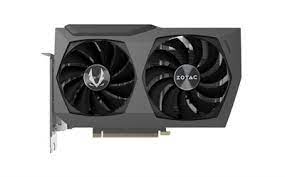
For many folks, the GeForce RTX 3070 is one of the best graphics cards on the market. It has performance comparable to last generation’s ex-flagship GPU, the RTX 2080 Ti. Because of its low price, the RTX 3070 is certainly a game changer, making 4K gaming accessible to everyone.
This is one of the first cards that will let you appreciate the beauty of so many pixels at 60 frames per second or higher. It may not be as powerful as its more powerful brothers, the RTX 3080 and 3090, but based on its present capabilities, it’s an amazing low-profile graphics card.
Being this powerful means it uses a lot of energy; the RTX 3070 is listed at 220W, but you’ll need at least 650W to ensure you have the power to run this beast of a GPU. Playing the newest AAA games at 4K and the highest graphics settings is feasible with a boost clock speed of up to 1725MHz and 8GB of GDDR6 RAM.
Getting frame rates of 65 to 80 should be no problem. If you’re playing more competitive titles, you can always reduce the resolution to 1440p and enjoy gaming at an astonishing 120 to 200 frames per second, albeit you’ll need a fast enough gaming display for that.
It also offers a variety of visual output connections, allowing you to play games and even conduct video editing. The RTX 3070 from Zotac is a dual-fan card that is significantly smaller than the Founder’s Edition or other GPUs. You’ll be able to fit this into any low-profile ITX setup and enjoy staring at your magnificent system while playing your favourite 4K game.
Price range: approximately $800
Technical Specifications
- VRAM: 8GB GDDR6
- 1.500MHz is the base clock speed.
- 256-bit Memory Bus Width
- Cuda Cores: 5888
- 12 DirectX
- ROPS-96
- Dimensions: 9.1 x 5.6 x 1.7 inches(LxWxH)
Pros
- incredible 4K performance.
- The best value in a low-profile GPU
- At its best, ray tracing
- It has an excellent cooling system for its size.
- It outperforms standard-sized GPUs in its class.
Cons
- The price is on the high side.
- A 12 pin power connection is required.
How to Choose the Best Low Profile Graphics Card
When it comes to designing a tiny form factor gaming setup, there are a few things to consider. The smallest low-profile GPUs are not always the best option.
Dimensions of a PC Case
Of course, you’ll need to consider the size you’re dealing with, which is normally dictated by the PC case. The mini-ITX motherboard will be the sole component you can rely on. Another story is how it fits inside the case of your choosing. There are several excellent PC cases available that should allow you to install even the largest low-profile graphics cards on the market today.
Workload
Workloads are another important element to consider. The more weight it has, the more powerful the GPU must be. The disadvantage here is that more powerful graphics cards rarely feature a single fan cooling system. However, there are several ITX cases that can accommodate a smaller twin-fan GPU.
Energy Consumption
Power supply and consumption are two of the more overlooked factors. A concern here is that a power supply for ITX designs is not available in high wattage ratings, so installing the graphics card of your choice may be difficult.
Heat
When you choose a compact form factor enclosure, all of your hardware components are crammed into a small space. The GPU, along with the CPU, is frequently the source of the most heat. This implies that your GPU’s cooling system must be extremely efficient. As a result, none of the passive cooling techniques will work.
Once you’ve determined this, determining the best low-profile graphics for your specific needs should be simple. Don’t bother about extra features like OC mode; just purchase the one that meets your demands. A graphics card with a low profile is always a tradeoff. Because you chose the tiny form factor path, that is your priority, and you would have to put in the best GPU possible.
Conclusion
If you’re planning on creating a low-profile PC case, one of these low-profile graphics cards is ideal. Some will perform better if you are ready to spend a significant amount of money on them, but the majority are quite cost-effective.
If you’re looking for leisure gaming, all of these cards will be able to perform to their specs, but if you’re into competitive gaming or want to become a professional gamer, a proper PC setup would be the best option.

